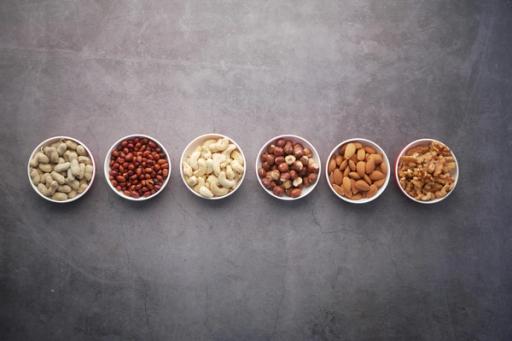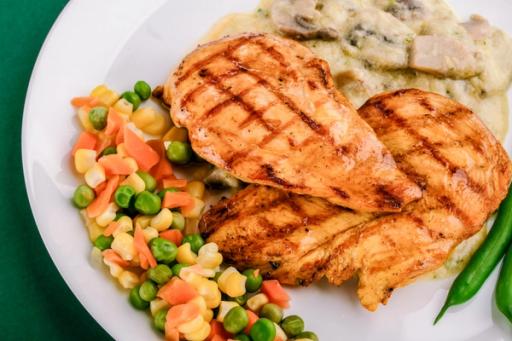
When trying to lose fat and gain muscle, hitting your protein target is especially important. Not only does protein help fuel muscle growth, but it also helps preserve existing muscle while losing weight. This makes protein crucial for a balanced body recomposition that improves overall fitness results. If you've been wondering, "How much protein for body recomp?" and "How to Hit Your Macros" you're not alone. This article will help answer your question about accelerating your transformation and reaching your goals.
A calorie tracker like Cal AI can help you hit your protein target for body recomp. By setting specific targets and tracking your macros, the app makes it easier to stay organized and focused on achieving your goals.

Body recomposition, or recomping, describes simultaneously losing fat and gaining muscle. This approach to transforming your physique goes beyond losing weight or gaining muscle; it targets body fat specifically while increasing lean mass. Dieting and exercise trends come and go (some should just go away). We know fad diets are generally a bad idea, and many exercise trends can be overwhelming, confusing, or even downright damaging if done impulsively or without preparation or guidance. So, what’s with this new one, body recomposition?
Body recomposition, or “recomping,” is a hot topic. Once mostly favored by weightlifters and bodybuilders who embraced it to lose fat and gain muscle simultaneously, the idea is going mainstream. “It’s being talked about a lot now, but if you step back a bit and don’t get caught up in the term ‘body recomposition,’ it’s not entirely new and it can be a beneficial, healthy lifestyle approach,” says psychologist, registered dietitian, and clinical exercise physiologist David Creel, PhD. “Whether you call it body recomposition or not, following a sensible eating and exercise routine can be beneficial for anyone, once they account for their own particular needs.”
In other words, body recomposition isn’t just for bodybuilders anymore. And despite the trendy and maybe misleading name, it can be a practical lifestyle and fitness approach for many of us. The term “body recomposition” first appeared within the fitness and bodybuilding communities. It describes using targeted exercise and diet to transform one's body shape or physique while shedding fat and building muscle.
In those circles, the technique promised showy results in a shorter time than traditional bodybuilding or “sculpting.” Traditionally, an athlete would bulk up first with heavy weight or resistance workouts and take in maximum calories, then switch to a low-calorie diet to shed the fat and reveal the muscle beneath. Achieving both fat loss and muscle increase simultaneously was considered the “holy grail” of bodybuilding. Some scoffed at the idea as impossible because, in simple terms, you need more calories to build muscle and fewer to lose fat, so how could you do both simultaneously? Dr. Creel says the overall approach of body recomposition can align with good, solid advice for living healthy when it strikes a balance between appropriate exercise and nutrition strategies.
“In the past, I worked with a lot of athletes wanting to simultaneously gain muscle and lose fat, but we never had a word for it,” Dr. Creel says. “Now, the term and concept are gaining popularity beyond bodybuilders and athletes. Although the idea of overhauling your body sounds appealing, it’s important not to get lured into programs that over-promise. There is no simple fix or silver bullet here.”
Some research indicates that “despite the zeitgeist that well-trained individuals cannot gain muscle mass and lose fat simultaneously, there have been many chronic randomized controlled trials conducted in resistance-trained individuals that have demonstrated body recomposition.” In other words, all hype aside, it can work.
Sometimes lost in the chatter about body recomposition is that if you plan on tracking your recomposition journey, you first need to know more about your current body composition, how much fat and muscle you have. (On the other hand, if you’re simply aiming for an integrated approach and you’re not fixated on the data, you can just do the work of exercising and eating smart.)
We’re not just talking about BMI here either. Body mass index, or BMI, simply estimates what an average person should weigh based on height. (To calculate your BMI, multiply your weight in pounds by height in inches squared, then multiply by a conversion factor of 703.) But that’s not enough information to reveal body composition.
To get an accurate estimate of how much muscle and fat you have, you’ll need help from your medical provider or a commercial product.
Dr. Creel says the “gold standard” for determining body composition used to be weighing people underwater. But today, providers may choose from among a variety of methods—from MRI (magnetic resonance imaging) to a DEXA scan (bone density test) to bioelectrical impedance (measuring the difference in electrical conductivity between the body’s muscle and fat tissue).

Let’s be clear: To make your body recomposition process as efficient as possible, you should eat plenty of protein. Research shows that higher protein intakes can help support muscle growth, recovery, and fat loss. So how much protein should you eat for body recomposition?
More Protein = Better Recomposition Results?
Alright. Now, what’s all this talk about an increased protein intake “guaranteeing” body recomposition success? We can trace it all back to the following two studies:
Here, the researchers randomly assigned participants into two groups. The first maintained their protein intake at 2.6 g/kg daily (i.e., “normal protein group”), while the other bumped it up to 3.3 g/kg daily (i.e., “higher protein group”). After eight weeks, both the normal and higher protein groups gained equivalent fat-free mass.
Notably, the higher protein group lost more fat mass despite reporting a higher daily calorie intake (roughly 500 calories).
Per the 2015 study mentioned above, the researchers randomly assigned participants into two groups. Only the control group consumed 1.8 g/kg of protein daily, while the high-protein group consumed a whopping 4.4 g/kg daily. The results? After eight weeks, there were no significant body composition differences between the two groups, despite self-reported calorie intake being nearly 800 calories higher daily (what!) in the high-protein group.
Do you now see what the hype is all about? Just taking the studies’ findings at face value, it’d appear that the higher protein groups managed to put on equivalent lean body mass and lose more body fat despite a higher calorie intake daily. Eat more calories and have a better physique—if that isn’t a “shortcut” to successful body recomposition, what is?
If It’s Too Good to Be True …
You know the saying: If it's too good to be true, it probably is. And that’s precisely the case when talking about this “shortcut” to “guaranteed” body recomposition. See, the thing about the studies above is that they involve self-reported numbers, which are prone to errors for two reasons:
Note: “Tightly controlled” means participants eat every morsel of food under the researchers’ watchful eyes.
Okay, so there’s no shortcut for successful body recomposition. So how should you distribute your macros in a body recomp diet then? Here’s a brief step-by-step guide:

The simple answer is... ALL OF IT. Your body can absorb an enormous amount of protein in a single meal, likely more than you could comfortably eat.
Although absorption simply refers to the passage of nutrients from the small intestine into the bloodstream, it’s essential to understand that just because protein is absorbed doesn’t mean it’s being used to build muscle. The real question is “How much protein can you USE in a single meal?”
This is where there’s some controversy. The earliest research suggested that 20 to 25 grams of protein in a single meal was all you needed to max out the anabolic response. It proclaimed that going above that amount didn’t do anything extra for muscle growth. Although often cited, let’s not be too quick to jump on board with this.
For a couple of reasons, I’m skeptical of this figure.
As you can see, although the amount of protein we can use per meal isn’t precise as of now, it’s likely higher than we used to think. Regardless, I think your protein intake per meal is less important than your daily protein intake.
Despite this realization, most experts still suggest that, from a digestion standpoint and for keeping muscle protein synthesis high throughout the day, spreading your protein out across three to five meals is likely best. Still, whether you eat two or six meals, as long as you hit your daily protein target, you will build muscle. I just suspect it might not be quite as optimal.
Is partly based on the amount of the amino acid, leucine. Leucine is essential because it’s the “trigger” for stimulating mTOR, which triggers new muscle growth. Since three grams of leucine is a decent ballpark figure for maximizing the anabolic response to a meal.
In the table below, you can see that whey protein comes out on top. Note that with just 29 grams of whey protein, you’ll get three grams of leucine for just 145 calories. You can also get three grams of leucine and 40 grams of protein from chicken breast, which would only cost me about 200 calories.
Moving down the list, you can see that you need to eat over 2,000 calories worth of whole wheat bread to hit three grams of leucine. Compare how it would take this much bread to give you the same anabolic punch as this scoop of whey protein powder.
As a general trend, animal protein sources are higher in leucine than their plant-based counterparts, especially per calorie. Nevertheless, this issue nearly disappears once we introduce vegan protein powders like soy, pea, and brown rice isolates, which also offer three grams of leucine for less than 200 calories.
Despite the importance of leucine in checking for protein quality, you still need the other eight essential amino acids (EAAs) actually to build the new muscle. For EAAs, we use the DIAA Score, where the higher the number, the more EAAs in that protein source.
Once again, you can see that dairy and animal proteins are at the top. A significant caveat in our analysis is that these tables all refer to proteins being eaten in isolation. In the real world, people combine various foods and are almost guaranteed to get enough leucine and enough EAAs by simply getting enough daily protein.
Although interesting and significant, this isn’t something I nitpick over, and it’s why I think PROTEIN QUALITY is much less important than many people realize. It’s also why supplementation of leucine, BCAAs, and EAAs usually isn’t necessary, as long as the total daily protein is sufficient. Nonetheless, vegan lifters should be a bit more strategic by either: Aiming toward the higher end of protein ranges, or supplementing a high-quality protein powder (Such as vegan whey, which combines pea and brown rice protein to give it a similar amino acid profile to whey protein.)
Despite the idea that “Your entire training session is wasted unless you eat protein within 30 minutes after training” was debunked years ago, many people still believe and adhere to it. In reality, as long as your pre-workout and post-workout meals are within roughly four- six hours of each other, you’ll be maximizing the anabolic response to training.
A possible exception to this would be if you train fast, in which case you should try to consume some protein as soon as you can after your workout.
Perhaps a more critical, but less discussed, timing variable is consuming protein before bed. The study referenced below from my friend, Jorn Trommelen and his colleague Luc Van Loon described pre-sleep protein as an essential protein-feeding opportunity. They suggest consuming roughly 40 grams of protein before an overnight fast to improve overnight muscle protein synthesis.
This is what I aim for personally, even though other longitudinal studies that directly tested consuming a slow-digesting casein protein either before bed or in the morning found no significant difference after 8-10 weeks. Still, both studies had subjects consume a very high protein intake overall, in the range of 2 grams per kilo or about 1 gram per pound. Once again, I highlight that these specific timing factors are much less important as long as total daily protein intake is sufficient.
In case you are wondering, there are also no legitimate safety concerns around a high-protein diet in healthy individuals. According to this gigantic position stand from the International Society of Sports Nutrition, “No controlled scientific evidence indicates that increased intakes of protein pose any health risks in healthy exercising individuals” and the amount of protein recommended in this blog has been shown over decades to not only be safe, but have health benefits.
Even going way above the recommendations here, as high as 4.4 grams per kilo or 2 grams per pound, has consistently resulted in no harmful effects.
Once more, I emphasize that the most important factor in protein utilization for muscle growth is your total daily protein intake. If you’re looking to optimize further, you can pay attention to how you distribute your protein throughout the day, with three to five meals most likely being the anabolic sweet spot.
These two factors alone will yield more than 90% of your potential results. Nevertheless, from an optimization standpoint, especially if you train fasted or have had a really long overnight fast, protein quality can be worth considering, and protein timing may have some benefit.

Body recomposition is a gradual process that varies based on factors like:
It’s not about hitting a target and moving on. “This may be a commonly asked question for any exercise or diet plan, but it’s not the right question,” says Dr. Creel.
“You’re not trying to get to a destination. It’s more of a lifelong practice. You can’t think you’re going to somehow shift your weight around by losing fat and gaining muscle and then be done with it. You’ve got to make it part of your life going forward.”
As for how long you’re likely to see initial effects from doing recomping, the timeline is going to depend as much on your factors:
In many cases, it may take weeks to months for effects to become noticeable, but Dr. Creel encourages you to “celebrate the small victories” along the way. Maybe you’re sleeping a bit better, your mood is improving, you have more energy, or your pants fit even the slightest bit differently even if nothing is showing up on the scale.
“It’s more important to approach this as a long-term lifestyle change and not a quick fix,” he states. “Sticking with it and staying with a balanced workout and nutrition are key to just feeling better overall. That is something you might notice even sooner than any change in your physique.”
Body recomposition can be safe, Dr. Creel says — but like any workout and diet plan, it also may not work out perfectly, or at all, for some people. Others might overemphasize certain parts to “get ripped.”
“But for me as a healthcare professional who is interested in health and function, body composition is really just one marker of health—not the whole story,” he continues. “Although our body shape and size are part of who we are, our physical and mental health impact our quality of life at a much deeper level.”
He adds that “healthy people naturally have different shapes, and even though having excess weight increases the risk of conditions like diabetes and heart disease, regular physical activity helps offset these risks. In the same vein, being lean and muscular doesn’t guarantee optimal health.”
Still, focusing on body recomposition as a lifestyle and maintenance plan and building a healthier relationship with food and exercise, rather than trying for quick weight loss or only bulking up, is a far better way to ensure that you’re doing the right things to keep your mind and body healthy and happy.
Seen in that way, Dr. Creel notes that body recomposition can be a holistic approach to fitness that prioritizes overall health and well-being.
The best way to hit your protein goals for body recomp is to track macros. But, like any other goal, it takes time and consistency. That's why a tracking app can help you stay organized and simplify the process. Cal AI transforms calorie tracking with our cutting-edge AI technology; just snap a photo of your meal, and we'll do the rest.
Our app combines your phone's depth sensor with advanced AI models to:
With 90% accuracy on visible foods and multiple tracking options, such as barcode scanning, food label recognition, and manual description for complex items like smoothies, we've made nutrition tracking effortless.
Gone are the days of tedious manual logging calorie tracking apps. Whether you're scanning a full meal or a quick snack, Cal AI gives you accurate nutritional information in under 15 seconds. Plus, our AI learns from your feedback, continuously improving its accuracy. Stay on track with personalized insights and smart reminders, Cal AI makes achieving your fitness goals simpler than ever.
Track your calories with your camera with Cal AI's AI calorie tracker today!